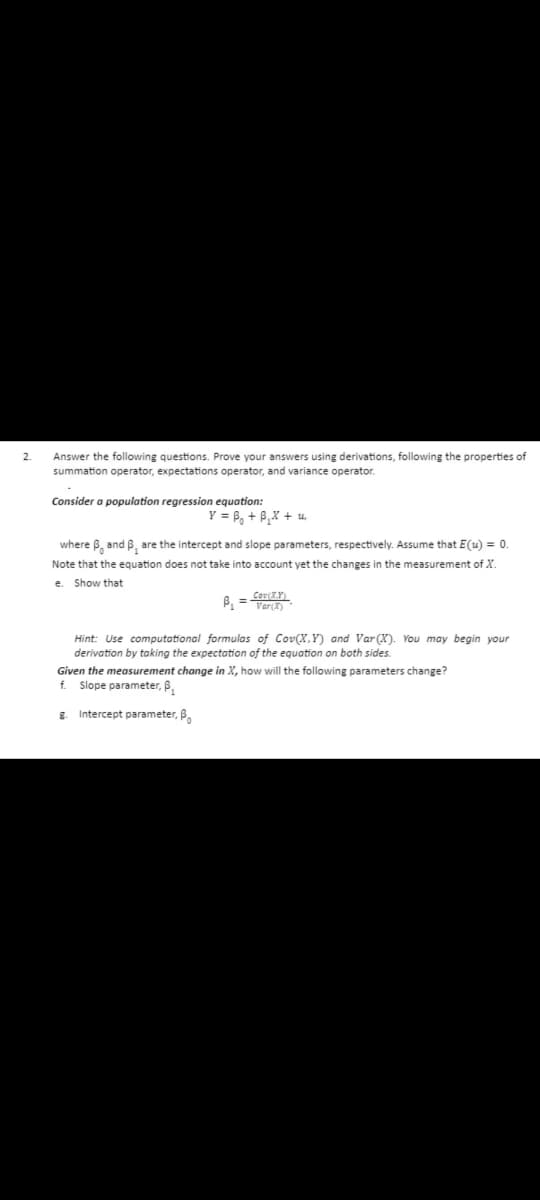2. Answer the following questions. Prove your answers using derivations, following the properties of summation operator, expectations operator, and variance operator. Consider a population regression equation: Y = P, + P,X + u. where B, and B, are the intercept and slope parameters, respectively. Assume that E(u) = 0. Note that the equation does not take into account yet the changes in the measurement of X. e. Show that Var) Hint: Use computational formulas of Cov(X,Y) and Var(X). You may begin your derivation by taking the expectation of the equation on both sides. Given the measurement change in X, how will the following parameters change? t. Slope parameter, ß. E Intercept parameter, ß,
2. Answer the following questions. Prove your answers using derivations, following the properties of summation operator, expectations operator, and variance operator. Consider a population regression equation: Y = P, + P,X + u. where B, and B, are the intercept and slope parameters, respectively. Assume that E(u) = 0. Note that the equation does not take into account yet the changes in the measurement of X. e. Show that Var) Hint: Use computational formulas of Cov(X,Y) and Var(X). You may begin your derivation by taking the expectation of the equation on both sides. Given the measurement change in X, how will the following parameters change? t. Slope parameter, ß. E Intercept parameter, ß,
College Algebra
7th Edition
ISBN:9781305115545
Author:James Stewart, Lothar Redlin, Saleem Watson
Publisher:James Stewart, Lothar Redlin, Saleem Watson
Chapter1: Equations And Graphs
Section: Chapter Questions
Problem 10T: Olympic Pole Vault The graph in Figure 7 indicates that in recent years the winning Olympic men’s...
Related questions
Question

Transcribed Image Text:2.
Answer the following questions. Prove your answers using derivations, following the properties of
summation operator, expectations operator, and variance operator.
Consider a population regression equation:
Y = B, + B,X + u,
where B, and B, are the intercept and slope parameters, respectively. Assume that E(u) = 0.
Note that the equation does not take into account yet the changes in the measurement of X.
e. Show that
Var(X)
Hint: Use computational formulas of Cov(X,Y) and Var(X). You may begin your
derivation by taking the expectation of the equation on both sides.
Given the measurement change in X, how will the following parameters change?
f.
Slope parameter, B,
Intercept parameter, B,
Expert Solution
This question has been solved!
Explore an expertly crafted, step-by-step solution for a thorough understanding of key concepts.
This is a popular solution!
Trending now
This is a popular solution!
Step by step
Solved in 3 steps with 3 images

Recommended textbooks for you

College Algebra
Algebra
ISBN:
9781305115545
Author:
James Stewart, Lothar Redlin, Saleem Watson
Publisher:
Cengage Learning

Functions and Change: A Modeling Approach to Coll…
Algebra
ISBN:
9781337111348
Author:
Bruce Crauder, Benny Evans, Alan Noell
Publisher:
Cengage Learning

Glencoe Algebra 1, Student Edition, 9780079039897…
Algebra
ISBN:
9780079039897
Author:
Carter
Publisher:
McGraw Hill

College Algebra
Algebra
ISBN:
9781305115545
Author:
James Stewart, Lothar Redlin, Saleem Watson
Publisher:
Cengage Learning

Functions and Change: A Modeling Approach to Coll…
Algebra
ISBN:
9781337111348
Author:
Bruce Crauder, Benny Evans, Alan Noell
Publisher:
Cengage Learning

Glencoe Algebra 1, Student Edition, 9780079039897…
Algebra
ISBN:
9780079039897
Author:
Carter
Publisher:
McGraw Hill